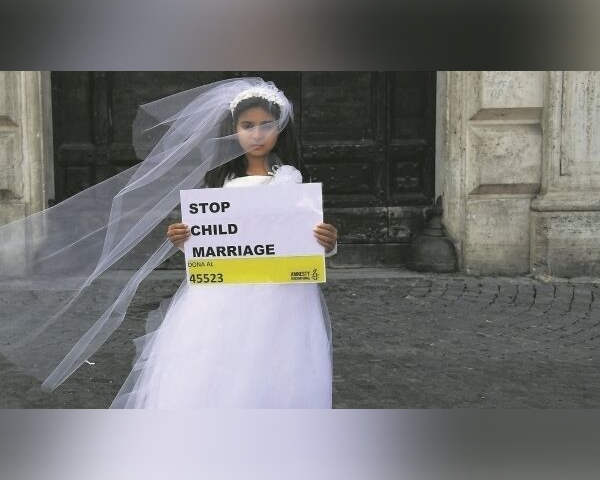
Qui a besoin d'un titre quand une image vaut mille mots?
Par : Giulia Ruscitti
Who is she? She is a daughter, she is a sister, she is a friend, she is a student, she is your neighbour, she is a bride.
12 million girls are married before the age of 18, that is 23 girls every minute, nearly 1 every 3 seconds (Girls Not Brides, 2020, “About Child Marriage” section). Girls are being forced into marriages around the world and something must be done to stop this. People are choosing to voluntarily turn a blind eye or refuse to take the time to become informed about this very important issue.
Child marriage is something that affects both boys and girls but unfortunately girls are far more affected by this very sad reality. Young girls that are married off are robbed of their childhood, they do not get to go to school with their classmates or play outside with their friends, they become wives, they become mothers before having had the chance to become adults. “Child marriage refers to any formal marriage or informal union between a child under the age of 18 and an adult or another child” (Child Marriage, 2021). It is not okay to ignore what is happening to these young girls simply because it is less prevalent in North America. “Girls who marry before 18 are more likely to experience domestic violence and… [it] can isolate girls from family and friends and exclude them from participating in their communities, taking a heavy toll on their physical and psychological well-being” (Child Marriage, 2021).
Countries have put laws in place that attempt to “protect” these types of marriages from taking place by setting a minimum age where persons can be married but regardless there are many loopholes; even in Quebec article 373 paragraph 2 of the Civil Code of Québec states that a minor can apply to the court for authorization to be married and that the person having parental authority will provide their advice to the court. This makes one realize that if loopholes exist in Quebec where laws have been put in place for numerous years, then how easy must it be in developing countries for minors to be married. “In 2016, UNICEF, together with UNFPA, launched the Global Programme to End Child Marriage… which supports households in demonstrating positive attitudes, empowers girls to direct their own futures, and strengthens the services that allow them to do so. It also addresses underlying conditions that sustain child marriage, advocating for laws and policies that protect girls’ rights” (UNFPA-UNICEF Global Programme to End Child Marriage, 2021). Measures have been put in place, but many persons still are oblivious or simply misinformed about this issue and even though UNICEF has made strides, they are solely focusing on countries most affected by this matter but for this unlawful practice to be eradicated they must focus on spreading the word globally.
The current COVID-19 pandemic has had an effect on each and every one of us. There are the obvious effects such as job losses, economic distress, business closures, health risks but there are also the underlying issues that the pandemic has caused. “The risk of child marriage increases through various pathways, including economic shocks, school closures and interruption in services” (COVID-19: A Threat to Progress Against Child Marriage, 2021). The pandemic has forced us to take a few steps back in the advancements made regarding child marriage. For many girls school is a refuge, a place where they are given the opportunity to learn and to find their voice but with school closures, they may have no other options than to be married, whether it is due to pressure by their families caused by economic distress or whether they no longer have the support system that they desperately are in need of. “Over the next decade, up to 10 million more girls will be at risk of becoming child brides as a result of the pandemic… but there are actions we can take now to protect girls that will also yield lasting benefits” (COVID-19: A Threat to Progress Against Child Marriage, 2021).
The road may not be easy, especially with roadblocks, such as the pandemic being put in the way, but it is nonetheless essential that “comprehensive social protection measures, safeguarding every child’s access to education and creating a protective legal and policy framework [are put in place]” (COVID-19: A Threat to Progress Against Child Marriage, 2021, para 4). It is essential that girls are given access to education where they can be informed about their rights against this practice and another crucial element is that more light is shed on this topic that unfortunately goes unreported and unaddressed.
References
Electronic
Child Marriage. (2021, March 07). Retrieved March 18, 2021, from http://www.unicef.org/protection/child-marriage
COVID-19: A Threat to Progress Against Child Marriage. (2021, March). Retrieved March 19, 2021, from https://data.unicef.org/resources/covid-19-a-threat-to-progress-against-child-marriage/
Girls Not Brides. (2020). Retrieved March 19, 2021, from https://www.girlsnotbrides.org/about-child-marriage/
UNFPA-UNICEF Global Programme to End Child Marriage. (2021, March 07). Retrieved March 19, 2021, from https://www.unicef.org/protection/unfpa-unicef-global- programme-end-child-marriage
Images
Leave Us Kids Alone: A Look at Child Marriage. (2018, December 15). [Photograph]. The Irish Examiner. http://www.irishexaminer.com/lifestyle/arid-30892211.html
